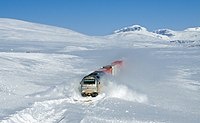
Photo from wikipedia
Quality attributes and water mobility of giant salamander jerkies (GSJs) during roasting process (160°C, for 0, 20, 40, 60, and 80 min) were investigated. The results showed that a ∗ ,… Click to show full abstract
Quality attributes and water mobility of giant salamander jerkies (GSJs) during roasting process (160°C, for 0, 20, 40, 60, and 80 min) were investigated. The results showed that a ∗ , b ∗ values and shear force increased of GSJs roasting from 20 to 80 min, while L ∗ , yield, and moisture content decreased significantly ( p < 0.05 ). Sensory assessment showed that GSJs at a roasting time of 40–60 min had higher scores. GSJs contained great amount of healthy unsaturated fatty acids (including DHA and EPA), and the total amino acids and essential amino acids were among 59.33–71.77 g·100 g−1 and 25.94–31.40 g·100 g−1, respectively. The mobility of the immobilized moisture and free moisture were shrunk dramatically during roasting. The proton density weighted images also exhibited the moisture shrinkage during roasting. In addition, T22 and T23 were positively correlated with MRI signal, moisture content, and yield of GSJs, but negatively correlated with shear force and overall acceptability, respectively. Thus, in view of various quality attributes and sensory evaluation, a roasting time of 40–60 min was favored for nutritive GSJs production. LF-NMR and MRI might be employed to profile the quality characteristics during roasting as a rapid and nondestructive analytical tool.
Journal Title: Journal of Food Quality
Year Published: 2021
Link to full text (if available)
Share on Social Media: Sign Up to like & get
recommendations!